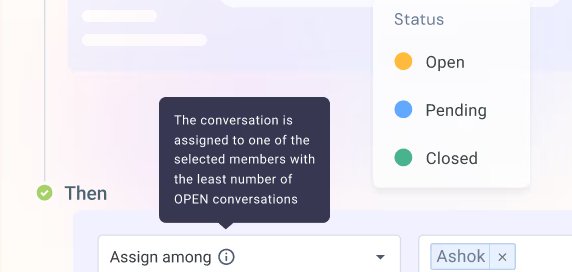A Complete Guide to Dynamic Email for Modern Businesses

Table of contents
With time, the technology we engage with is becoming increasingly personalized and automated.
Think about it: streaming platforms like Netflix and HBO show us content that almost seems made just for us. No matter if it’s another heartwarming rom-com or a thrilling drama, it’s like the algorithm gets us.
Social media? It’s the same story. We scroll through posts that match our interests, and even our music streaming apps, like Spotify, are creating playlists that capture our moods perfectly.
This kind of personalization makes us feel like we’re living in our own movie, where everything revolves around what we like. And it’s not just a nice touch—it’s something customers have come to expect from the brands they follow.
In fact, a report from McKinsey & Company shows that 71% of customers now expect companies to offer them personalized interactions.
To meet this growing demand, many businesses are turning to dynamic email.
But what exactly is it?
In this guide, we’ll discuss dynamic emails, why they matter, and how you can use them to create a more personalized customer experience. Let’s get started!
What is Dynamic Email?
Dynamic email is a type of email marketing that lets you tailor your message for each recipient based on their preferences, behaviors, and collected data. It’s an interactive way to make your emails more relevant and engaging for your audience.
For instance, you might send out a mass email to your entire marketing list.
While these emails may use a standard template, each recipient receives a slightly customized message that addresses them by name, references a previous purchase, or recommends specific offers.
A dynamic email from a customer service team could include personalized follow-ups based on a customer’s recent interactions, offering tailored solutions or product recommendations related to their previous inquiries.
Dynamic emails are a powerful marketing strategy because they adapt to the needs and preferences of recipients while remaining cost-effective at scale. With dynamic email marketing, you can personalize various elements—from text and visuals to calls to action. This approach makes your marketing messages more relevant to your target audience, boosting engagement overall.
How Dynamic Email Differs from Static Email
Dynamic emails bring a level of personalization that static emails just can’t match.
Unlike static emails, which show the same content to every recipient, dynamic emails adjust based on the recipient’s behavior, location, or device. This means every recipient gets an email experience tailored just for them, which can boost engagement and drive more conversions.
With dynamic emails, businesses can leverage customer data—like age, location, or gender—to customize the content each person sees. It’s like having a conversation that’s specific to the individual rather than delivering a generic message. Whether it’s showcasing location-specific offers or creating a personalized product lineup, dynamic emails provide a more engaging, interactive experience for the recipient.
Think of static emails as a one-size-fits-all approach. They send everyone the same product recommendations or promotions without considering individual preferences.
On the other hand, dynamic emails offer a much more personalized experience by delivering unique content to different audience segments. These emails can include GIFs, interactive product carousels, videos, or even game-like elements to capture attention.
The Psychology of Dynamic Email: Why Personalization Works
Ever wondered why certain emails make you want to click, while others get sent straight to the trash? It’s all about psychology.
Dynamic emails tap into a fundamental human desire: the need to feel understood and valued.
When people receive personalized content that speaks to their individual interests or needs, it triggers an emotional response. This isn’t just marketing fluff—it’s backed by science.
The Power of Feeling Seen
According to psychology, people are more likely to trust the sender when they feel recognized personally. It’s like walking into your favorite coffee shop and having the barista know your order—it makes you feel valued.
Dynamic emails create this effect by showing content that resonates with each person individually.
The Dopamine Hit of Relevance
When an email shows relevant products, services, or offers, the brain releases a hit of dopamine—the “feel-good” chemical. This little burst of pleasure happens when something aligns with our interests or preferences.
It’s why personalized recommendations are so powerful—they make people feel excited, understood, and, most importantly, ready to take action.
Dynamic emails use this psychological trigger to drive engagement and ultimately influence purchasing decisions.
A Two-Way Conversation
Static emails are like someone talking at you.
Dynamic emails, on the other hand, feel like a conversation where both sides are involved. This shift from one-sided messaging to interaction creates a sense of relationship and trust.
When people feel heard and catered to, they’re more likely to engage. The result? Higher click-through rates, more meaningful interactions, and stronger brand loyalty (we’ll discuss this later in the article in detail!).
Benefits of Using Dynamic Email
If an inbox is overflowing with messages, it can be challenging for your email to stand out. However, dynamic email content can be your secret weapon for capturing your audience’s attention, encouraging deeper engagement, and driving those crucial conversions.
Here’s why it’s a game-changer for keeping your audience engaged and nudging them closer to that ‘buy’ button.
Your Engagement Rates Will Soar
Dynamic emails do what static ones can’t—they grab attention. With interactive elements like GIFs, videos, and product carousels, your audience is far more likely to engage. You won’t give the recipients just another email to scroll past; you’ll provide them with an experience.
And guess what? When customers engage more, they’re more likely to stick around and take action. Say goodbye to dull open rates and hello to emails that spark interest!
It’s Personal, Just Like Your Favorite Playlists
Ever had Spotify create a playlist that’s so spot-on, it feels like magic?
Dynamic emails work the same way. Instead of generic messages, they use data like your customer’s location or past behavior to deliver content that feels tailor-made for them.
As mentioned before, when your email speaks directly to someone’s preferences, they’re way more likely to feel connected—and that connection leads to loyalty.
Even studies show that personalizing the subject line can result in a 26% boost in open rates.
Your Conversions Will Be Boosted
At the end of the day, it’s all about results—and dynamic emails are designed to convert.
By showing the right products or offers to the right people, you’ll naturally see more clicks, purchases, or sign-ups.
When people see content that’s relevant to them, they’re far more likely to hit that “buy now” button. Personalized emails can improve click-through rates by 14% and boost conversion rates by an additional 10%. This tailored approach enhances campaign performance and leads to a higher ROI.
In fact, businesses using dynamic emails often see noticeable improvements in conversion rates, turning casual browsers into paying customers.
Types of Dynamic Email Content
Dynamic emails open up a world of possibilities for engaging your audience. With the ability to tailor content to individual preferences, you can create a more meaningful connection with your customers.
Here are three powerful types of dynamic email content that can take your email marketing to the next level.
Personalized Product Recommendations
Personalized product recommendations curate a shopping experience tailored to each customer. By leveraging data like past purchases and browsing history, businesses can highlight items that resonate with individual preferences.
This level of personalization makes customers feel valued and significantly boosts the chances of conversions. When customers see products that catch their eye, they’re more likely to click through and purchase.
Location-Based Content
Location-based content takes personalization a step further by incorporating geographical data. Whether it’s a local event, weather updates, or regional product availability, this type of content speaks directly to customers’ surroundings.
For example, a retail brand might send emails featuring promotions for items relevant to a specific season in the recipient’s area. By recognizing and addressing local needs, businesses can create a sense of relevance that encourages engagement and drives foot traffic to physical stores.
Behavioral Triggers
Behavioral triggers are the ultimate game-changer in dynamic email marketing.
These are automated emails triggered by specific actions or behaviors—like abandoning a shopping cart, browsing certain products, or even celebrating a birthday.
For instance, if a customer leaves items in their cart, an email reminding them of those products can be sent, often with an enticing discount to encourage conversion. By responding to customer actions in real-time, businesses can create a sense of urgency and relevance that compels recipients to take action.
Implementing Dynamic Email: Best Practices
Let’s explore these best practices to help you make the most of your dynamic email campaigns!
Data Collection and Management
Effective dynamic emails start with robust data collection and management. Gather information from various touchpoints, like website visits, purchase history, and customer interactions. This data will allow you to personalize emails in meaningful ways.
You’ll also have to ensure that your data is organized, accessible, and regularly updated.
The more accurate your data, the more relevant your content will be, leading to improved engagement and conversions.
Segmentation Strategies
Segmentation is your secret weapon for dynamic email success. By dividing your audience into distinct groups based on behaviors, preferences, or demographics, you can send targeted messages that resonate with each segment.
Consider creating segments based on past purchases, engagement levels, or even customer feedback. Tailoring content to specific groups ensures that your emails are relevant, increasing the likelihood of interaction and conversion.
Testing and Optimization
Never underestimate the power of testing!
Continuously evaluating your dynamic email campaigns is crucial for understanding what works best. A/B testing allows you to determine the most compelling subject lines, content layouts, and call-to-action buttons. You can refine your approach over time by analyzing the insights from these tests.
Remember, optimization is an ongoing journey. Stay open to adjusting your strategies based on performance data and customer feedback. This proactive approach not only enhances your campaigns but also ensures you consistently meet the evolving needs of your audience.
Compliance and Privacy Considerations
Respecting customer privacy is non-negotiable. So, ensure your data collection practices comply with relevant laws, such as GDPR or CCPA.
Moreover, be transparent with your customers about how their data will be used and provide options for them to manage their preferences. By prioritizing compliance and privacy, you build trust with your audience, encouraging them to engage confidently with your dynamic emails.

With Hiver’s email management solution, you can manage customer interactions while keeping compliance and privacy at the forefront. This makes it easier to create effective, personalized campaigns that respect your audience’s preferences.
Here are some key features that enhance your dynamic email strategy:
- Shared Inbox: Collaborate seamlessly with your team using a shared inbox, allowing multiple users to manage customer emails without losing context or accountability.
- Email Automation: Streamline your workflow with automation features that enable you to set up automated replies, reminders, and task assignments, saving time and reducing manual effort.
- Email Templates: Create and save customizable email templates to ensure consistent messaging while enabling quick responses tailored to various customer interactions.
- Insights and Analytics: Gain valuable insights into email performance with analytics that track open rates, response times, and team performance, helping you make data-driven decisions.
- Compliance Management: Stay compliant with privacy regulations like GDPR and CCPA by utilizing Hiver’s features that facilitate transparent data collection and user consent management.
- Collaboration Tools: Use notes and tags to collaborate on emails with your team, ensuring everyone is aligned and informed on customer interactions and follow-ups.
These features empower you to effectively manage customer interactions while maintaining a strong focus on compliance and privacy, ensuring your email campaigns resonate with your audience.
Challenges in Dynamic Email Implementation
While dynamic emails can revolutionize your marketing strategy, they come with their own set of challenges.
Navigating these issues effectively is essential to harnessing the full potential of dynamic email campaigns:
Technical Hurdles
Dynamic email campaigns often require a robust technical infrastructure. Issues like poor email rendering across different devices can frustrate recipients.
For example, if an email doesn’t display properly on your device, you’ll likely delete it. This means that a technical glitch can directly impact your engagement rates and conversions.
Moreover, integrating dynamic email features with existing marketing platforms can be complex, leading to potential delays in implementation and additional costs.
Data Quality Issues
The effectiveness of dynamic emails is related to the quality of your data. Inaccurate, outdated, or incomplete information can undermine your personalization efforts.
A study by Experian found that one in five companies believe that about 29% of their customer data is inaccurate. This can result in irrelevant product recommendations or content that fails to resonate with recipients.
Investing in regular data cleaning and validation processes is crucial to ensure that your dynamic emails deliver meaningful and accurate messages.
Balancing Personalization and Privacy
Finding the right balance between personalization and privacy can be tricky.
While consumers appreciate tailored experiences, they also want their data to be handled with care. According to a survey by Pew Research Center, 77% of Americans are concerned about how companies use their data.
It’s essential to be transparent about your data practices and provide users with clear options to manage their preferences. Striking this balance can enhance trust and encourage engagement without compromising privacy.
Transform Your Email Strategy With Dynamic Emails
Dynamic email content isn’t just a passing trend in retail marketing—it represents a fundamental shift in how we engage with our customers. By creating personalized experiences at scale, dynamic content is becoming an essential tool for marketers aiming to stand out in a crowded inbox.
If you haven’t started leveraging dynamic content in your email marketing yet, now is the perfect time to do so. Hiver’s shared inboxes, email tracking, and powerful collaboration features is designed to help teams manage emails efficiently and stay on top of their communication.
So, what are you waiting for?
Sign up today to discover how Hiver can help engage your audience and drive conversions!

































